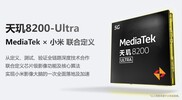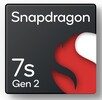MediaTek Dimensity 8200-Ultra vs Qualcomm Snapdragon 7s Gen 2
MediaTek Dimensity 8200-Ultra
► remove from comparison
The MediaTek Dimensity 8200-Ultra is a upper mid-range ARM-based SoC (system-on-a-chip) that is manufactured using the modern 4 nm process. It was specially designed for use in Android smartphones and is in the upper class in terms of performance. It supports all current mobile communication standards, including 5G SA.
The CPU works with a total of eight cores, which are divided into two clusters. In the first cluster, an ARM Cortex-A78 power core clocked at 3.1 GHz is joined by three further ARM Cortex-A78 power cores clocked at 3 GHz. In the second cluster, four ARM Cortex-A55 power cores operate at 2.0 GHz. LPDDR5 RAM can be used as RAM and UFS 3.1 is supported as internal memory.
In terms of connectivity, dual 5G with a theoretical peak download speed of up to 4.7 GBit/s is available, as well as WiFi 6E and Bluetooth 5.3.
The Mediatek Dimensity 8200-Ultra is a variant of the otherwise identical Mediatek Dimensity 8200 that has been specially customised for Xiaomi and features improvements to the camera ISP. An Imagiq 785 image processor is responsible for processing the camera data. Video recordings are supported with up to 4K at 60 fps. The CPU part of the older Dimensity 8100 is very similar and offers the same CPU and GPU cores.
The integrated ARM Mali-G610 MC6 graphics unit can power displays with a resolution of up to 2,960 x 1,440 pixels (WQHD+) and a refresh rate of up to 120 Hz. With Full HD+, even up to 180 Hz is possible.
Qualcomm Snapdragon 7s Gen 2
► remove from comparison
The Qualcomm Snapdragon 7s Gen 2 (SM7435-AB) is an ARMv9-A-based SoC for tablets and smartphones in the upper mid-range segment.
The Qualcomm Snapdragon 7s Gen 2 integrates a total of 8 cores divided into two clusters. The ARM Cortex-A78 cluster for high performance offers four cores with up to 2.4 GHz. The remaining 4 cores are based on the more energy-efficient A55 architecture and can be clocked at up to 1.95 GHz. All cores can run simultaneously or just a single cluster.
The SoC is similar to the Snapdragon 7 Gen 1 which offers a slightly lower clocked efficiency cluster and a different named GPU. The similar named Snapdragon 7+ Gen 2 is clearly faster with newer CPU cores. Although the naming suggest it, there was no Snapdragon 7s Gen 1.
LPDDR5 RAM is supported, with a frequency of up to 6,400 MHz.
The Snapdragon X62 5G modem is used as the modem. It supports a range of SA and NSA 5G mmWave and sub-6 GHz frequencies as well as Dynamic Spectrum Sharing (DSS). The X62 can achieve a maximum downlink speed of up to 2.9 Gbit/s in 5G networks.
The Adreno 710 forms the graphics subsystem. The GPU is capable of driving FHD+ displays at up to 144 Hz.
The Qualcomm Snapdragon 7s Gen 2 is manufactured using the modern 4nm EUV process.
| Model | MediaTek Dimensity 8200-Ultra | Qualcomm Snapdragon 7s Gen 2 |
| Codename | Cortex-A78 / A55 | Cortex-A78 / A55 |
| Clock | 2000 - 3100 MHz | 1950 - 2400 MHz |
| L3 Cache | 4 MB | |
| Cores / Threads | 8 / 8 1 x 3.1 GHz ARM Cortex-A78 3 x 3.0 GHz ARM Cortex-A78 4 x 2.0 GHz ARM Cortex-A55 | 8 / 8 4 x 2.4 GHz ARM Cortex-A78 4 x 2.0 GHz ARM Cortex-A55 |
| Technology | 4 nm | 4 nm |
| Features | ARM Mali-G610 MC6 GPU, Dual 5G modem, WiFi 6E, Bluetooth 5.3, H.264/HEVC video decoding | |
| iGPU | ARM Mali-G610 MP6 | Qualcomm Adreno 710 |
| Architecture | ARM | ARM |
| Announced | ||
| Manufacturer | www.google.com | www.qualcomm.com |
| Series | Qualcomm Snapdragon |
Benchmarks
Average Benchmarks MediaTek Dimensity 8200-Ultra → 100% n=22
Average Benchmarks Qualcomm Snapdragon 7s Gen 2 → 78% n=22
* Smaller numbers mean a higher performance
1 This benchmark is not used for the average calculation











